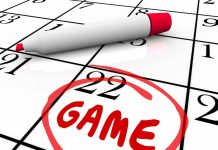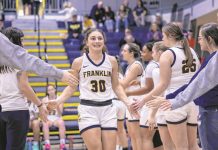Ali Patberg didn’t think anything of it at first.
She had just hurt herself while playing defense during a Nov. 2 practice at Notre Dame. The freshman point guard from Columbus North wasn’t immediately concerned. Maybe a dislocated knee, she thought — nothing that would stop her from getting back into practice after a few minutes.
But it didn’t take long for the Fighting Irish staff to realize the situation with Patberg’s right knee was far more serious than that.
“The trainer (Anne Marquez) was there, and she came out and she kind of felt it,” Patberg said. “I asked if I could keep playing because I felt fine, and she said, ‘Well, let’s go check it out in the training room.’ And I walked off the floor, and our team doctor (Mike Yergler) was there — he was in that day — and he kind of just pulled on my leg, and he told me I tore my ACL, most likely.”
Patberg’s mother, Julie Davis, was on the receiving end of the initial phone call.
“It’s just one of those, ‘No, please be an ankle,’” Davis said.
Just like that, Patberg’s first season of college basketball went up in smoke.
“We actually talked on the phone before practice,” said Columbus North girls assistant basketball coach Ron Patberg, “And then it was maybe like 3:20, and her mom called me, crying, and I was like, ‘What’s going on? What’s wrong?’ And she’s like, ‘Well, they think Ali tore her ACL at practice.’ I’m like, ‘I just talked to her 45 minutes to an hour ago.’ So it was a little bit shocking.”
“My dad came up to me and said, ‘Did you hear about Ali?’” added Ali’s sister, Kenzie, a sophomore guard for the Bull Dogs. “I said, ‘What about her?’ And he said, ‘She might have torn her ACL.’ And I was kind of in shock — I was like, ‘Ali? My sister Ali?’”
A not-so-exclusive club
Patberg, who earned Indiana Miss Basketball and McDonald’s All-American honors while leading North to a state championship and a top-10 national ranking last season, became the next athlete among a long line of them to be sidelined by the injury.Each year, about 200,000 people suffer injuries to the anterior cruciate ligament, more commonly known by the acronym ACL, and the overwhelming majority of those cases are related to agility sports such as basketball, football, skiing and soccer. Of the four major knee ligaments, the ACL is the one most responsible for stability in the joint.While male athletes suffer more ACL injuries overall than female athletes due to greater participation numbers, the risk is far greater for females, experts said. Depending on the sport in question and which medical source you consider, female athletes are anywhere from two to 10 times more likely to suffer an ACL tear than their male counterparts, and the difference is greater in basketball than in other sports.
The Notre Dame women’s basketball program has dealt with this situation many times.
The Fighting Irish lost Natalie Achonwa for the 2014 Final Four after a torn ACL in the regional final, and Brittany Mallory and Devereaux Peters both missed most of the 2008-09 season due to ACL injuries. Former Notre Dame All-American Skylar Diggins suffered the same fate during a WNBA game this summer. Diggins, like Patberg, is doing the bulk of her rehab work in South Bend, and she has reached out to offer words of encouragement to the freshman.
Why the difference? Researchers have found several contributing factors. Some of those are obvious, others less so.
The most easily distinguishable difference between male and female bodies is the shape. Women’s hips are spread wider than those of a man, putting their legs at more of an angle. The difference in how the knee is impacted during motion, particularly laterally, is a major reason why women suffer ACL tears more frequently.
Another big factor is muscle strength. The greater the imbalance between the strength of the quadriceps and the hamstring, the greater the risk of ligament injury. Women tend to suffer in this regard — the average male hamstring muscles have 70 percent of the strength that the quadriceps do, while the average female hamstrings have only half the strength of the quads.
A female’s monthly menstrual cycle can also come into play. Because of the stretching that takes place during child birth, a woman’s ligaments tend to be naturally looser than a man’s — and not just in the pelvic region. How taut those ligaments are can vary greatly throughout a monthly cycle, which helps to explain why females who use a birth-control pill suffer fewer ligament tears.
The long road ahead
During the Thanksgiving break, Patberg was back in Columbus, watching her former North teammates practice and play and doing her rehab exercises with Columbus North trainers Steve Souder and Robyn Coffer.Having undergone surgery Nov. 24 in South Bend, Patberg is on crutches and still in the early stages of recovery. The first step will be regaining full range of motion in the knee. Getting the leg back to full strength comes next, and then resuming sport-specific activities is the final step.Many years ago, a torn ACL often meant the end of an athlete’s career. It remains a serious injury, but improvements in sports science have helped to speed up the recovery process.
According to Dr. Cary Guse of Southern Indiana Orthopedics, the basics of ACL surgery haven’t changed much in his 18 years working in sports medicine. What has changed dramatically is the rehabilitation.
“Initially, we put people in a brace or a cast for four weeks, and you gradually get her moving,” Guse explained. “Now, they’re walking on it from day one, bending it from day one. I expect most of my ACL (patients) to have full range of motion by week four.”
Once an athlete regains normal range of motion, the next step is to rebuild strength before eventually returning to sport-specific activities.
The timetable can very greatly depending on the sport, the individual and whether there was any structural damage elsewhere in the knee, but Patberg is expected to be able to return to action after eight to 10 months.
“We tell them usually six months, but at the D-I level like her, I think that’s (more accurate),” Guse said. “For that level, having that power and explosion is critical. Being 90 percent and being 98 percent is a big difference at that level, because the athletes are so skilled.”
The biggest hurdles in a comeback today, Souder said, are not physical.
“It’s a psychological hurdle that they have to overcome more than anything else,” the longtime North trainer said. “It used to be more the physical part, and you didn’t even worry about the psychological part. But now, it could be up to a year after the surgery that they’re still worried about feeling that sensation again, that sound, of it giving out. You look at NFL players and NBA players when they’ve had the ACL surgery. You can tell they’re just apprehensive about going full-go.
“Some people, it doesn’t faze them. I’ve seen soccer players that have come back and they don’t even think about it. Everybody’s different.”
The toughest part for Patberg might be fighting her natural desire to treat her recovery like a race.
“Just the other day,” she said, “(Marquez) told me to take … two days off this week, and I looked at her like, ‘Uh, are you sure I should take off?’ And she’s like, ‘Yeah. You need your body to recover, and it needs time to heal, too.’ So I want to go, go, go, but …
“I just have to trust everyone around me. I have to trust my trainer. I have to trust that they’re going to have me do the right thing so that I’m going to be the strongest when I come back, and I just have to know that if I do something that I’m not supposed to do, that that’s going to hurt me in the long run.”
Patberg had a stress fracture in her foot the summer before her junior year at North, but she has never been on the shelf for a significant amount of time. Davis said she can’t recall her daughter going this long without playing since she was 4 years old.
“So it’s definitely going to be a change for her,” Davis said, “but I think it’s just going to make her stronger eventually.”
From every angle
Instead of dwelling on the negatives, Patberg — who said she wants to be a coach when her playing days are over — is using her time on the sideline to master the game from a different perspective.The Princeton-style offense that Notre Dame coach Muffet McGraw runs is one of the most potent in the nation, but it’s also one of the most complex — especially for a point guard. Patberg admitted to being a bit overwhelmed when she first arrived in South Bend.“Before the injury, it was hard,” she said. “They told me coming in that being a point guard for their program and the offense we run, it would be really difficult. It’s hard to pick up the offense, and it’s hard to run, and so I think this year, me watching it and learning all the plays and knowing everything obviously will help me in the long run.”
She’ll have plenty of resources at her disposal.
The Fighting Irish already had an accomplished point guard in junior third-year starter Lindsay Allen. McGraw ran the point in college, and assistant Niele Ivey was the floor general for Notre Dame’s 2001 national championship team.
“She’s moved up by the coaches (during games), which I think’s going to be very beneficial for her to understand the expectations of the kids and of the system,” Ron Patberg said. “Being a point guard, I think she was a little overwhelmed, at least initially, with all the things that were required of her, and I think, honestly, this is going to be very valuable for her over the long term. In fact, (McGraw) was telling me that they’re thinking about allowing Ali to scout some of the opposing teams. That’ll be good for her and keeps her involved in the game.”
“I’m not afraid to ask questions,” Ali Patberg said, “so I can pick everyone’s brain and really just take everything in.”
There will be plenty to take in away from the court as well. After going through the mandatory Freshman Year of Studies program at Notre Dame, Patberg will be going into the Mendoza College of Business, one of the nation’s top-rated undergraduate business schools.
Patberg won’t have any problem staying busy between now and next season. The recovery process will be a long and difficult one, both mentally and physically.
But soon enough, she’ll be back on the hardwood, with a full four years of college basketball ahead of her.
“People haven’t lied to me and told me it’s going to be easy,” Patberg said. “They’ve told me it’s going to be hard, but I’ll come out stronger.”
“It stinks that she has to go through the pain and the process of rehab,” her father said. “But if somebody’s built for it, she is.”
[sc:pullout-title pullout-title=”Coming back from ACL injuries” ][sc:pullout-text-begin]
Several women’s basketball stars have suffered season-ending ACL injuries before and come back just as strong, if not stronger. Here are a few notable cases.
Candace Parker tore the ACL in her left knee before her senior year of high school. She came back less than six months later to lead her team to a repeat state title before sitting out her first year at Tennessee, where she went on to win two Wooden Awards and two national championships. She is a two-time WNBA MVP.
Monique Currie missed her sophomore season at Duke with an ACL tear. She came back in 2003, became an All-American for the Blue Devils and was picked in the first round of the 2006 WNBA draft. Currie suffered a second ACL injury in 2011 but has played nine full WNBA seasons, averaging 10.6 points.
Devereaux Peters tore the ACL in her left knee twice while at Notre Dame. She returned to become a two-time Big East Defensive Player of the Year and a first-round pick in the WNBA draft. Peters has helped the Minnesota Lynx win two NBA titles in three years.
Niele Ivey, now an assistant coach at Notre Dame, sat out most of her freshman year with the Fighting Irish after an early-season ACL tear in her left knee, then missed the 1999 NCAA tournament after suffering the same injury to her right knee. Ivey came back and led Notre Dame to the 2001 national championship in her fifth year before enjoying a five-year career in the WNBA.
Jackie Gemelos suffered an ACL tear in her final high school game and four more during her career at USC. At age 26, she finally achieved her dream of making it to the WNBA this year.
Not every story has a happy ending, though.
Shea Ralph suffered five ACL tears — two on her right knee, then three more in her left — after arriving at the University of Connecticut. The first of those caused her to miss the 1997-98 season. Ralph returned to become a first-team All-American and win a national title in 2000, but she missed the 2001 NCAA tournament and never played a game in the WNBA.
[sc:pullout-text-end][sc:pullout-title pullout-title=”The Ali Patberg file” ][sc:pullout-text-begin]
Height: 5-10
Class: Freshman
Position: Guard
College: University of Notre Dame
Accomplishments: Graduated from Columbus North with 4.07 grade-point average; led Bull Dogs to Class 4A state championship, averaging 25.9 points, 8.8 rebounds, 6.1 assists and 3.1 steals; was named Miss Basketball and Gatorade Player of the Year in Indiana; finished as school’s all-time leader in points (2,026 points), assists (534) and steals (273); holds eight other single-game and single-season school records; played in McDonald’s All-American Game; won gold medal with Team USA at U-19 World Championships in Russia.
[sc:pullout-text-end]




